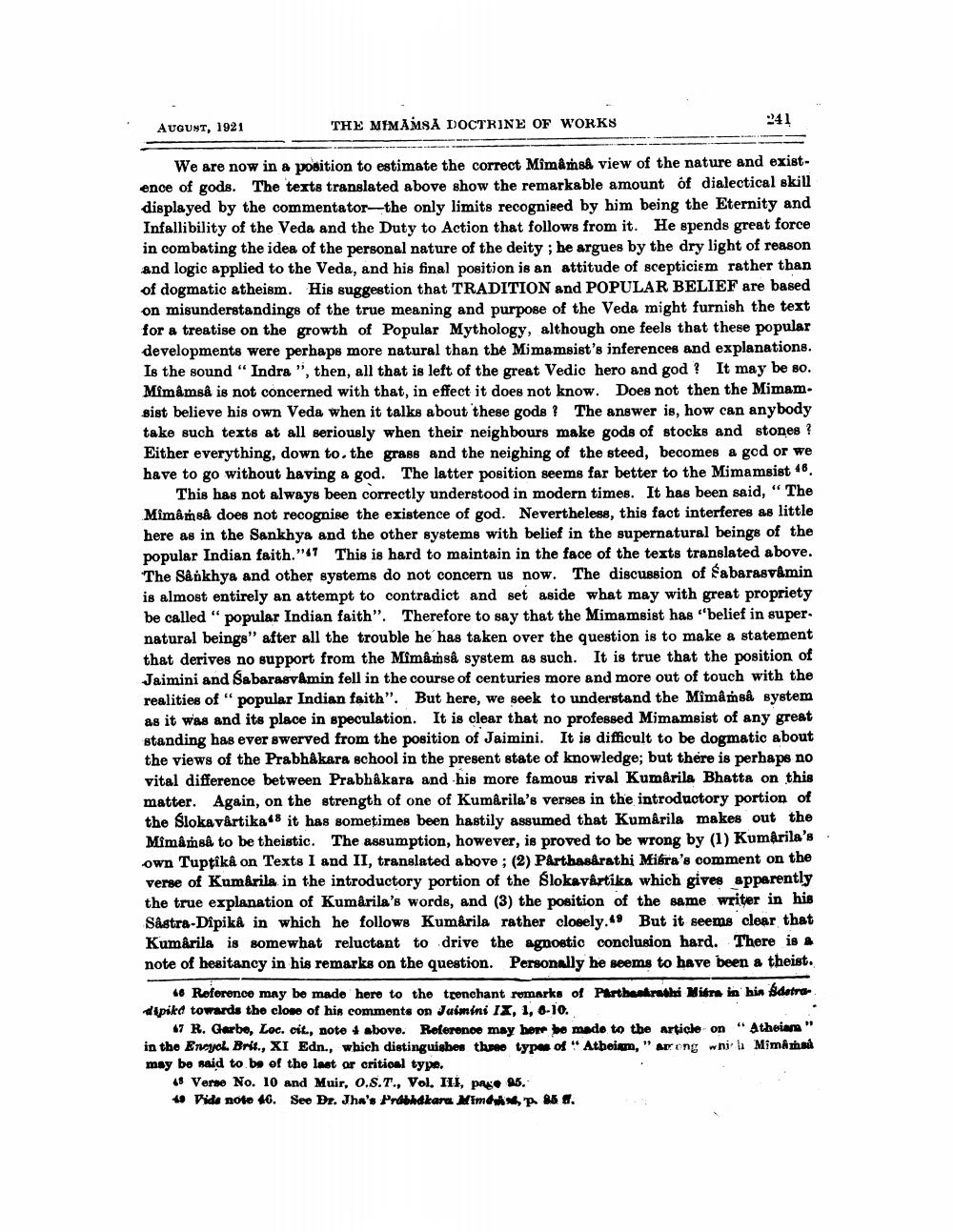________________
AUGUNT, 1921
THE MEMAMSA DOCTRINE OF WORKS
We are now in a position to estimate the correct Mimamsa view of the nature and existence of gods. The texts translated above show the remarkable amount of dialectical skill displayed by the commentator-the only limits recognieed by him being the Eternity and Infallibility of the Veda and the Duty to Action that follows from it. He spends great force in combating the idea of the personal nature of the deity ; be argues by the dry light of reason and logic applied to the Veda, and his final position is an attitude of scepticiem rather than of dogmatic atheism. His suggestion that TRADITION and POPULAR BELIEF are based on misunderstandings of the true meaning and purpose of the Veda might furnish the text for a treatise on the growth of Popular Mythology, although one feels that these popular developments were perhaps more natural than the Mimamsist's inferences and explanations. Is the sound "Indra ", then, all that is left of the great Vedic hero and god ? It may be so. Mimâmsê is not concerned with that, in effect it does not know. Does not then the Mimamsist believe his own Veda when it talks about these gods? The answer is, how can anybody take such texts at all seriously when their neighbours make gods of stocks and stones ? Either everything, down to the grass and the neighing of the steed, becomes a ged or we have to go without having a god. The latter position seems far better to the Mimamsist 0.
This has not always been correctly understood in modern times. It has been said, “The Mimâms does not recognise the existence of god. Nevertheless, this fact interferes as little here as in the Sankhya and the other systems with belief in the supernatural beings of the popular Indian faith."'47 This is hard to maintain in the face of the texts translated above. The Sankhya and other systems do not concern us now. The discussion of tabarasv&min is almost entirely an attempt to contradict and set aside what may with great propriety be called "popular Indian faith". Therefore to say that the Mimamsist has belief in supernatural beings" after all the trouble he has taken over the question is to make a statement that derives no support from the Mimâmsâu system as such. It is true that the position of Jaimini and Sabarasvmin fell in the course of centuries more and more out of touch with the realities of " popular Indian faith". But here, we seek to understand the Mimâmsê system as it was and its place in speculation. It is clear that no professed Mimamsist of any great standing has ever swerved from the position of Jaimini. It is difficult to be dogmatic about the views of the Prabhakara school in the present state of knowledge; but there is perhaps no vital difference between Prabhakara and his more famous rival Kumârila Bhatta on this matter. Again, on the strength of one of Kumarila's verses in the introductory portion of the Slokavårtikas it has sometimes been hastily assumed that Kumârila makes out the Mimâms to be theistic. The assumption, however, is proved to be wrong by (1) Kumarila's own Tuptika on Texts I and II, translated above ; (2) Párthasarathi Misra's comment on the verse of Kumarila in the introductory portion of the Slokavartika which gives apparently the true explanation of Kumarila's words, and (3) the position of the same writer in his Sastra-Dipikâ in which he follows Kumârila rather closely.49 But it seems clear that Kumârila is somewhat reluctant to drive the agnostic conclusion hard. There is note of hesitancy in his remarks on the question. Personally he seems to have been a theist.
46 Roforence may be made here to the trenchant remarks of Partheskratki Witra in hin detradipike towards the clone of his comments on Juimini IX, 1, 6-10.
17 R. Garbo, Loc. cit., note 4 above. Reference may here to made to the article on "Atheiana" in the Encyck. Brit., XI Edn., which distinguishes three type of " Atheism," arrong whirl Mimámad may be said to be of the last or critioal type.
18 Verne No. 10 and Muir, O.S.T., Vol. III, page 95. 4 Vide note 46. See Dr. Jha's Prabhakara Wim , p. 85 8.




